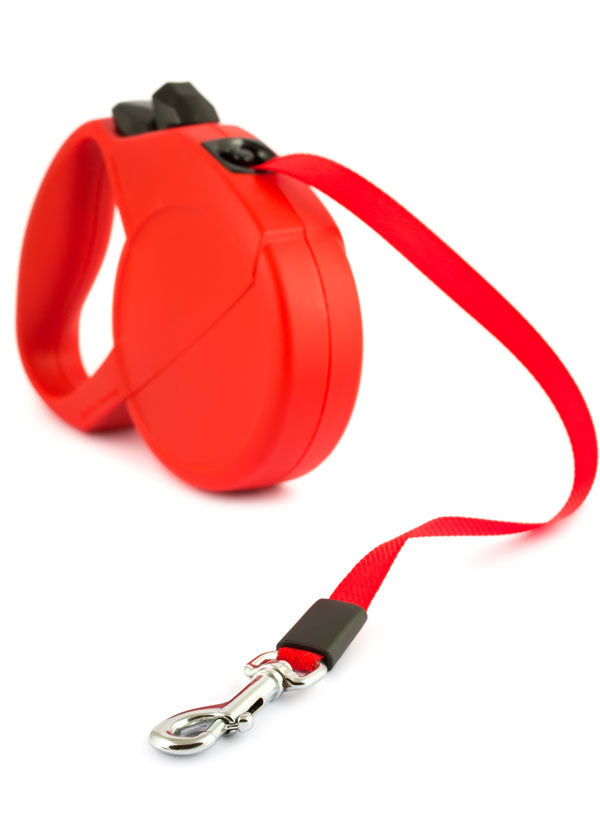
Making wise leash and collar choices for your best friend
Today I would like to discuss retractable leash injuries in dogs. Before I begin, I want to tell you that it is not my intention to upset anyone or tell you that you are hurting your dog. My intention is to make you aware of some of the problems with retractable leashes so you can prevent injuries and keep your dog healthy for years to come.
At first glance, retractable leashes appear to be a great compromise when our dogs can’t be off leash. They seem benign and give a dog a wider range to roam and keep him or her safe.
 However, from a practical point of view, the leash spring applies a continual force through the collar and presses on vital structures in the neck including the thyroid gland, jugular vein, carotid artery and numerous cervical nerves which supply the chest and the forelegs.
However, from a practical point of view, the leash spring applies a continual force through the collar and presses on vital structures in the neck including the thyroid gland, jugular vein, carotid artery and numerous cervical nerves which supply the chest and the forelegs.Here are the most common issues caused by retractable leashes:
1. Paw licking is often a result of neck damage and injury. If you have ever had a sore neck, you know that it can present with numbness or a “pins and needles” sensation in your hands. Dogs are no different. What they usually do in such cases is lick and chew on their paws. Most of these dogs are misdiagnosed with allergies.
2. Armpit scratching is similar. Neck injuries often lead to referred sensation/pain into the thoracic or front legs or can cause tightness of the armpit muscles.
3. Hypothyroidism. If you have ever seen an image of the thyroid gland, you would notice that it is very superficial in the neck and is therefore prone to physical damage. It is positioned near the Adam’s apple. An injury to the gland usually results in inflammation and the body creates antibodies against the thyroid gland. These antibodies lead to the selective destruction of thyroid cells resulting in a decrease in hormone production called hypothyroidism.
4. Ear scratching and infections are also frequently related to collar and leash injuries. It appears that dogs that have injured their upper cervical spine – C1-C3 are especially prone to ear problems. The neck is crucial for providing the energy flow to the ears and without a doubt collar injuries play an important role. I have addressed chronic ear infections in another article.
5. Epilepsy/seizures can also be triggered or aggravated by neck injuries and pulling on the leash. Pressure on the jugular vein increases intracranial pressure which can increase the likelihood of epilepsy in a predisposed dog. Neck energy stagnation is also known to affect the flow of cerebral-spinal fluid.
I expect some people will disagree with my opinion. People often ask me where the double-blinded studies confirming this are.
In 30 years in veterinary practice, I have treated thousands of dogs with problems described above and they have responded well to having their necks adjusted and switching them to a no-pull harness.
It is true I could spend valuable time trying to prove my observations by doing studies, but such studies are expensive and not necessary to prove something that is already self-evident.
I hope this info will bring a new understanding of why I recommend using a harness such as the Perfect Fit Harness in place of a collar. In reality, there is no safe way of using a retractable leash the same way there is no safe way of driving in a car without the seatbelt.
There is another option to test the effect a retractable leash. Tie it to a post or tree, put a collar on your neck, clip it to the leash and RUN. I would love you to share your experience with me.
Dr. Peter Dobias
PS: Here are some interesting questions and comments from our Facebook page about retractable leashes.
-
Why do they still sell retractable leashes? This is a good question. I think some people will sell anything unless it is illegal to sell and then they will try to sell it anyway.
-
Michelle Steward shared with us her dog’s story: “My beagle was caught up in one due to an irresponsible owner on the other end. He ended up pulling hard on the leash as his dog and mine were completely tangled and getting agitated. The result was the cord on the leash completely “degloving” the skin on my beagle’s entire leg. Ended up with three surgeries, thousands of dollars and weeks of hell… I will never recommend these leashes to anyone!!”
-
Mona Persson shared with us her experience: They (retractable leashes) can cause serious injury to humans, too. I have scars to prove it!
-
Kingstone Chiro wrote: Did you cover the potential damage to the neck when the dog hits the end if the leash? I have seen a number of these doggy patients!
-
Devon Mary Ward wrote: My dog got dragged down a hill by his back leg screaming in pain because someone dropped their retractable leash when their dog hit the end. The dog circled my dog and then took off with poor Thor in tow.
© Dr. Peter Dobias, DVM